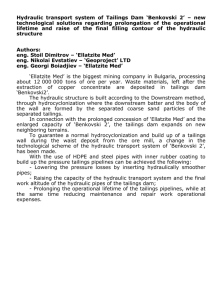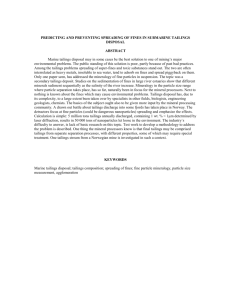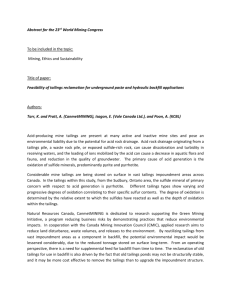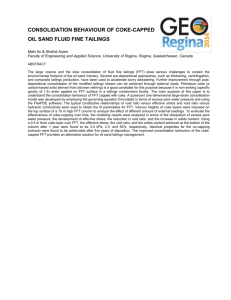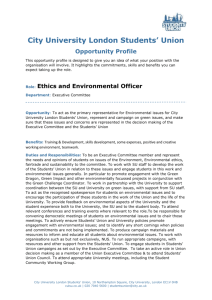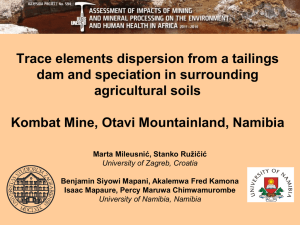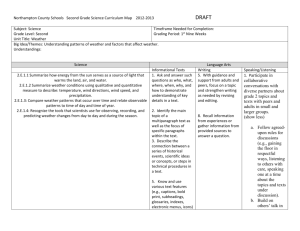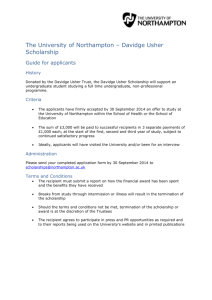MINUTES NLTP STEERING COMMITTEE MEETING 12 March 2015
advertisement
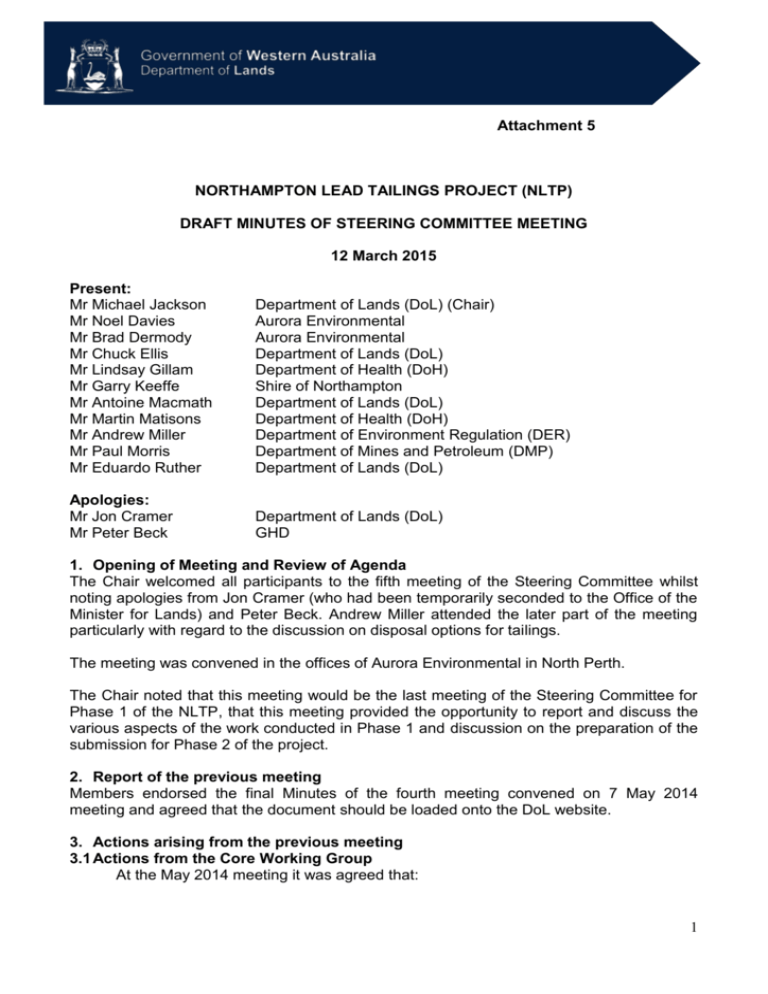
Attachment 5 NORTHAMPTON LEAD TAILINGS PROJECT (NLTP) DRAFT MINUTES OF STEERING COMMITTEE MEETING 12 March 2015 Present: Mr Michael Jackson Mr Noel Davies Mr Brad Dermody Mr Chuck Ellis Mr Lindsay Gillam Mr Garry Keeffe Mr Antoine Macmath Mr Martin Matisons Mr Andrew Miller Mr Paul Morris Mr Eduardo Ruther Department of Lands (DoL) (Chair) Aurora Environmental Aurora Environmental Department of Lands (DoL) Department of Health (DoH) Shire of Northampton Department of Lands (DoL) Department of Health (DoH) Department of Environment Regulation (DER) Department of Mines and Petroleum (DMP) Department of Lands (DoL) Apologies: Mr Jon Cramer Mr Peter Beck Department of Lands (DoL) GHD 1. Opening of Meeting and Review of Agenda The Chair welcomed all participants to the fifth meeting of the Steering Committee whilst noting apologies from Jon Cramer (who had been temporarily seconded to the Office of the Minister for Lands) and Peter Beck. Andrew Miller attended the later part of the meeting particularly with regard to the discussion on disposal options for tailings. The meeting was convened in the offices of Aurora Environmental in North Perth. The Chair noted that this meeting would be the last meeting of the Steering Committee for Phase 1 of the NLTP, that this meeting provided the opportunity to report and discuss the various aspects of the work conducted in Phase 1 and discussion on the preparation of the submission for Phase 2 of the project. 2. Report of the previous meeting Members endorsed the final Minutes of the fourth meeting convened on 7 May 2014 meeting and agreed that the document should be loaded onto the DoL website. 3. Actions arising from the previous meeting 3.1 Actions from the Core Working Group At the May 2014 meeting it was agreed that: 1 Aurora would prepare a Working Paper on the bioaccessibility of Northampton lead. The paper will be referred to Steering Committee members for comment and ultimately endorsement. Shire and community members of the Steering Committee would be invited to the Technical Workshop On the basis of the bioaccessibility studies, Aurora would review all data from properties in Categories 1 and 2 and make an assessment of those properties which are recommended for further consideration in Phase 2, and those properties on which no further action is required. Members noted that these actions had been completed. Further discussion is set out under item 4. 3.2 Summary of DoH blood lead testing and home visits At the May 2014 meeting it was agreed that DoH would prepare a report on the interviews with residents with properties in Category 1 and the results of subsequent blood lead testing of residents. This matter is discussed under item 7. 3.3 Reporting of Phase 1 of the NLTP to Northampton Residents At the May 2014 meeting it was agreed: DoL would prepare a draft letter intended for residents and circulate this to Steering Committee members for comment. DoL would provide advice to residents on the results of Phase1 together with a cover letter and Q and A sheet. The advice would include whether any further action is or is not required. DoL would provide details of a contact officer if residents require further information. This advice would be conveyed by registered mail. These matters are further discussed under item 6. 3.4 Options for disposal of lead tailings At the May 2014 meeting it was agreed: Aurora would provide selected representative samples of Northampton tailings material to the ChemCentre for leachability testing studies. Northampton Shire would establish a suitable bin or bunded holding area at the current Northampton landfill site for the temporary holding of lead tailings. These matters are further discussed under item 8. 4. Phase 1 of the NLTP - Overview and Outcomes. Members noted: That the ‘Northampton Lead Tailings Project Phase 1 Investigation Report’ dated 5 February 2015 and prepared by Aurora Environmental had been circulated to members for comment prior to the meeting. A presentation on the Phase 1 of the NLTP introduced by Noel Davies. The key objectives for Phase 1 were: To identify the presence and distribution of tailings To determine those properties without tailings To classify “OUT – those properties which were not affected by tailings and therefore required no further consideration in the NLTP” To determine those properties with tailings To classify “IN – those properties requiring remediation/management in Phase 2” 2 Provide remediation and management options for affected properties The scope of Phase 1 included the following: Data gaps analysis of all previous work conducted in Northampton Preparation of a Sampling and Analysis Plan Inspect and sample 683 properties (out of 759 in town), plus 18 properties near town Background lead soil concentration assessment Lead bioaccessibility assessment (tailings and soil) Development of the Northampton Action Level (NAL) Groundwater assessment (desktop), and pXRF data quality evaluation There is minimal use of ground water in the town of Northampton. The reticulated water supply for the town is provided from Geraldton. Rain water tanks are used in the town. The Shire uses ground water for the reticulation of public open spaces in the town. Levels of lead in ground water were relatively low. Members considered that ground water does not present a widespread problem in the town. Originally the Project was envisaged as three separate phases as follows: Phase 1 – screening exercise to simply identify properties with tailings Phase 2 – investigate extents of tailings an develop remediation/management strategy Phase 3 – implement remediation/management strategies During Phase 1 the Steering Committee had decided to condense the project in two phases as follows: Phase 1 – identify properties with tailings, determine the extents and develop remediation/management strategies Phase 2 - implement remediation/management strategies. Members agreed that this had been a more efficient use of resources and time for the overall project. This decision will provide government with more definitive details of the work required in Phase 2. That Aurora had conducted a series of ‘sub phases’ in Phase 1 as follows: Phase 1a – initial rounds of inspections and sampling Interim letters provided by DoL to land owners had provided information on those properties: Where tailings had been identified and therefore the property required further investigation and management in Phase 2 Where there was no evidence of tailings and therefore no further investigation was required, and Where initial investigations were not conclusive and therefore further assessment was needed Phase 1b – additional sampling on properties where tailings were not observed in Phase 1a, but with some other line/s of evidence that tailings may be present Phase 1c – selected properties with tailings further investigated to better understand typical tailings extents Additional Phase 1a - conducted on additional properties where consent was obtained through directly writing to land owners. Phase 1b was implemented, as required, at the same time. The outcomes of Phase 1 can be summarised as follows: Lead bioaccessibility in Northampton properties had been determined to be 50%. 3 The Northampton Action Level (NAL) had been determined by DoH to be 600mg/kg 123 properties were found to be affected by tailings i.e approximately 18% of all properties. These properties were therefore classified ‘IN’ for Phase 2. Of these properties 95 properties had observed tailings and a further 28 properties had soils on which the impact of tailings was strongly suspected. 578 (82%) properties were considered not affected by tailings and were classified ‘OUT’ i.e. no further investigation is required in Phase 2. Aurora had estimated that approximately 11,600m3 of tailings or tailings impacted soils required to be remediated in Phase 2. Data gaps had been addressed. Improved methodology for pXRF measurements had been achieved. The pXRF instruments had proved to be invaluable in this project. The ability to achieve on site ‘on the spot’ determinations of lead concentrations had enabled immediate decisions to be taken for further sampling. This would not have been possible if a sampling and analysis procedure had been undertaken using only laboratory analysis. The use of pXRF instruments would be equally useful in the remediation work envisaged in Phase 2 of the project. Approximately 5,500 samples had been taken in Phase 1 of the project. The outcome of this methodology had provided a high degree of confidence for the work completed. Concentrations of lead found in tailings were in the order of tens of thousands mg/kg. Not all of the 123 properties found to be affected by tailings were residential properties or used for community purposes. Some, for example, were used for industrial purposes, others were public open spaces or vacant land. It is therefore possible to prioritise the Phase 2 remediation of these properties with a focus on those which are used for residential purposes. Members requested Garry Keeffe to provide details of the current use, (including if the sites were currently vacant) of each of these 123 properties. The two main options to address possible exposure and health risks arising from lead tailings are: Excavate tailings and dispose of these at a yet to be identified location, and Cover and contain tailings where they are now. Removal provides more certainty and doesn’t leave a legacy issue for current or future owners Removal is not always practical where tailings are present beneath structures Recommended approach is to remove as much tailings as possible but some tailings are likely to be contained The removal of tailings provides more certainty and doesn’t leave a legacy issue for current or future owners The approach recommended by Aurora is to remove as much of the tailings as possible whilst recognising that some tailings are very difficult to remove and likely to be contained Aurora recommended that the key aspects of the remediation and or management in Phase 2 are as follows: Increased level of engagement with property owners Agreement on final approach and explain scope of works Minimise disruptions and avoid concerns during works Reinstatement of property Final advice to property owners 4 A civil works-type contactor would be required (but one used to dealing in small scale works) Documentation and validation for reporting to DER Need to identify disposal facility type and location The construction of a local disposal facility for the tailings removed. Members thanked Aurora for their excellent, professional and rigorous management of Phase 1 of this project Action: Garry Keeffe to provide details of the current use of the 123 properties determined to contain, or be affected by lead tailings. 5. Media coverage Members noted: A Media release headed “Northampton Lead Tailings Project over 80% of properties no evidence of tailings” had been prepared and released by DoL on 9 March 2015. A copy of the Release had been circulated to Steering Committee members prior to the meeting. Chuck Ellis advised that the release was provided to the ABC Midwest reporter who had been following the Project. A radio interview with the reporter was aired on 11 March 2015. This covered the points in the media release. GWN had followed up on this initial report and Mr Ellis would be conducting a further interview following this meeting (i.e.12 March). Mr Ellis anticipated that the Geraldton Guardian would also report on the status of the NLTP. Members considered that the media coverage on the NLTP had been well managed. 6. Notification of results to Northampton Residents Members noted: Advice from Eduardo Ruther on the current status on the mail out of letters to Northampton residents of the results of testing properties in Phase 1. At the time of the meeting, DoL had completed sending out all of the letters to land holders whose properties were classified as ‘IN’ Phase 2 i.e. tailings had been identified on their property and further remediation/management was required. DoL is currently working on those letters to residents whose properties were classified as ‘OUT’ for Phase 2 i.e. no further remediation or management was required. These letters would be despatched on 12/13 March 2015. This means that all of the residents and landowners in the Northampton township will know the status of their properties within the next few days. The letters are signed off by the Director General of DoL. There are no postal deliveries to homes in Northampton so most residents use post office boxes for their mail deliveries. Some residents own more than one property and these individual properties may be ‘IN’ or ‘OUT’. Therefore quality assurance of all information is very important in compiling these letters. This notification was the first official advice that property owners had received since the investigation had begun. A copy of the templates used for the ‘IN’ and ‘OUT” letters is set out in Attachments 2 and 3 of this report. The Steering Committee recognised the importance of this task. 5 7. Report by DoH on blood lead testing and home visits Members noted: DoH officers were currently finalising their report to the Steering Committee on the interviews conducted with residents whose properties had lead concentrations above the Northampton Action Level (NAL) i.e. those properties which are to be included in Phase 2. DoH officers had conducted further visits to residents in Northampton earlier in the week of the meeting on 9-10 March. The purpose of these visits was to encourage residents to undergo blood lead testing and provide advice on how this could be so easily undertaken and point out where the elevated level/s were detected on the property so that residents (especially children) did not approach that area. In addition, and where applicable, to provide advice on how to exercise strict cleaning methods in order to minimise lead exposure. DoH had visited the residents in 75 Northampton premises identified by the project team as having elevated lead concentrations due to lead tailings or elevated lead levels in soils due to tailings. Some difficulties had been encountered in meeting with the residents of these premises because some of the premises were holiday homes, vacant for extended periods, or residents had not returned telephone calls necessary to confirm visiting arrangements. DoH had made particular efforts to provide advice to Aboriginal and Torres Strait Islander families living in Northampton who may not have been part of mainstream communication efforts. DoH had observed that most residents in Northampton were elderly and aware of the mining history of Northampton and particularly the mining and milling of lead containing ores. DoH had made arrangements with the Northampton and Geraldton hospitals for the provision of free blood lead testing for Northampton residents. This offer remained ongoing for any resident. Of the 21 blood lead tests carried out on Northampton residents, one person had a blood lead level (BLL) of 5µg/dL, the highest recorded. The previous National Health and Medical Research Council (NH&MRC) recommendation was that “All Australians should have a blood lead level below 10µg/dL, and that children’s exposure to lead should be minimised”. The NH& MRC had recently revised this recommendation, with the revised level now set at 5µg/dLor lower for all Australians. However, as a direct result of lead contamination in the Esperance region several years earlier, DoH had previously introduced a policy for children under five years of age that a blood lead level of 5µg/dL or above was the threshold level warranting further environmental investigation with the view to minimising or preventing exposure to the source of lead. Members acknowledged the significant commitment made by DoH in setting up the procedure for blood lead testing and arranging visitation to Northampton residents. Advice from DoH is that the levels of lead found in Northampton residents presenting for blood lead testing are considered consistent with those levels which could normally be expected in a community, whilst recognising that the total number of Northampton residents undertaking testing was relatively small. DoH advised that it had not seen any evidence linking health related issues to lead tailings distributed around Northampton. 6 DoH officers will finalise their report which will be circulated to Steering Committee members following the meeting. Action: DoH to circulate to Steering Committee members, the report on health assessment of the public health risk posed to Northampton residents from lead exposure. 8. Phase 2 of the NLTP and options for disposal of lead tailings Members noted: Advice from Andrew Miller on the options for disposal of lead tailings identified in the NLTP. Andrew Miller and Jon Cramer had visited Northampton earlier in the week of this meeting to inspect potential sites for the disposal of lead tailings. The two most likely sites in the Northampton area are the Commonage site and the Wheal Ellen site. The Wheal Ellen site is west of the town. There are several disused mine shafts and old workings together with large quantities of lead tailings on the site. There is extensive erosion of the tailings and runoff onto neighbouring pastoral land. The Commonage site is northwest of the town. The site has good access roads. There are no previous workings at this site. The site is undisturbed and has a rock base. In order to progress the development of a containment cell facility it would be necessary to prepare an application for works approval. Such applications can be submitted online. Applications are submitted to and assessed by the Mid West Regional Manager of DER. Advice from Noel Davies that he had developed a preliminary context plan for a containment cell. He envisaged this to be a low profile cell [as distinct from the existing pyramid shaped cell in Northampton], appropriately bunded with an impervious clay capping which would be then sealed with soil for vegetation. It is possible to design a containment cell which would allow further tailings to be added at a future time. The containment cell could be opened for further material at intervals of 3 to 5 years according to the quantities of further tailings material for containment. In the event that additional tailings were to be added, this could be achieved by removal of the bund and extending the cell. The administrative process for adding further material to the containment cell would require a further works approval application. Mr Miller advised that the Contaminated Sites Management Account (CSMA) was not a potential source of funding for the works approval application because funds in the CSMA have been fully committed. DoL is seeking alternative sources of funding for the costs of developing the necessary works approval application. The time frame for the works approval application must be completed by the end of the financial year. The Steering Committee considered that the containment cell should be primarily intended for the disposal of lead tailings and associated lead contaminated soils from the NLTP. However, members considered that the cell could also be used for tailings with high concentrations of copper and zinc from the Northampton district. 7 Advice from Paul Morris that any potential site(s) for the containment cell should be checked with DMP to ensure that the site(s) was not identified by DMP as a site of potential economic mineralisation with a potential for future mining activities. The Steering Committee considered that it would not be practical to transport tailings from the Wheal Ellen site to another site (such as the Commonage site). Therefore in the event that only one site is selected for the containment cell, the Wheal Ellen site would be preferred. The works approval application would need to be prepared, the containment cell would need to be designed, accurately costed and approved before a submission to government is made for Phase 2 of the Project. It is planned that the submission to government for Phase 2 would be a joint submission with DoH and DER as had been the case with the initial submission for Phase 1 of the project. It was planned that the submission to government would be made about mid 2015. The draft submission for Phase 2 would be circulated to Steering Committee members for comment prior to its circulation to directors general and ministers. Members estimated that the approximate total cost for Phase 2 of the project including the costs of the containment cell would be in the order of $3-5million. Advice from Garry Keeffe that the Shire and the Northampton community in general were very appreciative of the work by agencies in Phase 1 of the NLTP and were supportive of the next stage of the Project. Actions: 1. DoL to identify a source of funding and progress the works approval application for the containment cell. 2. DMP to be consulted on potential sites for the containment cell to ensure that the site(s) have not been identified by DMP as a site of potential economic mineralisation with a potential for future mining activities. 3. DoL to progress the submission to government for Phase 2 of the NLTP. 9. Close of meeting In closing the meeting the Chair acknowledged and thanked all members of the Steering Committee for their valued participation and contribution to the NLTP. It was envisaged that the Steering Committee would have a continued role and function in Phase 2 of the Project. 8 Attachment 1 NORTHAMPTON LEAD TAILINGS PROJECT STEERING COMMITTEE MEETING 12 March 2015 SUMMARY OF ACTIONS 1 Phase 1 of the NLTP - Overview and Outcomes. Action: Garry Keeffe to provide details of the current use of the 123 properties determined to contain, or be affected by lead tailings. 2 Notification of results to Northampton Residents Action: DoH to circulate to Steering Committee members, the report on health assessment of the public health risk posed to Northampton residents from lead exposure. 3 Phase 2 of the NLTP and options for disposal of lead tailings Actions: DoL to identify a source of funding and progress the works approval application for the containment cell. DMP to be consulted on potential sites for the containment cell to ensure that the site(s) have not been identified by DMP as a site of potential economic mineralisation with a potential for future mining activities. DoL to progress the submission to government for Phase 2 of the NLTP. 9 Attachment 2 Enquiries: Jon Cramer Ph: 65524684 Our ref: PIN Type 1st line of address here Type 2nd line of address here Type 3rd line of address here Dear Type name here NORTHAMPTON LEAD TAILINGS PROJECT Thank you for your involvement in the Northampton Lead Tailings Project (NLTP). This letter refers to the findings from the investigation on your property at Street Address (Lot XX) Northampton (see attached plan). As a result of the assessment undertaken on your property (assessment overview attached) it has been determined that there is sufficient evidence to suggest the presence of lead tailings on your property. Department of Lands will now be considering options available for management of the lead tailings on your particular property. This process will be undertaken as part of Phase 2 of the project. Further advice will be provided as to the timing and scope of these works at a future date. Due to the risks associated with removing the tailings, and the current legal restrictions on where the tailings could be deposited, it is important you do not attempt to remove the tailings yourself. If you currently reside at this property, you should by now have been contacted by Department of Health (DoH) officers to receive some preliminary advice in relation to the matter. In some cases, this has proved difficult, so if contact has not yet been made, please contact Lindsay Gillam, Principle Policy Advisor in the DoH, on 9388 4961 during normal office hours. A free blood lead testing program is also available for residents in the Northampton townsite as part of this current project. Further advice on these matters can also be provided by Mr Gillam. It is advised that general hygiene measures in regards to minimising exposure to lead impacted soils should continue to be observed. These measures, and additional information on the project, are set out on the dedicated project webpage: www.lands.wa.gov.au/northampton For more information on your particular property please contact the department’s Contaminated Sites Section on: Phone: +61 8 6552 4400 10 Email: northamptonlead@lands.wa.gov.au Thank you once again for your participation in this project. Yours sincerely Colin Slattery DIRECTOR GENERAL 26 February 2015 11 Attachment 3 Enquiries: Jon Cramer Ph: 65524684 Our Ref: PIN Type 1st line of address here Type 2nd line of address here Type 3rd line of address here Dear Type name here NORTHAMPTON LEAD TAILINGS PROJECT Thank you for your involvement in the Northampton Lead Tailings Project (NLTP). This letter refers to the findings from the assessment on your property at Street Address (Lot XX) Northampton (see attached plan). Following this assessment (investigation overview attached) it has been determined that there is no evidence to suggest that your property has been impacted by lead tailings. As a result of this finding, there is no reason for your property to continue to form part of the current project. It is advised that general hygiene measures should continue to be observed given that naturally occurring lead and other metals exist in Northampton due to region’s geology. These measures and additional information on the project are set out on the dedicated project webpage: www.lands.wa.gov.au/northampton Thank you once again for your participation in this project. Yours sincerely Colin Slattery DIRECTOR GENERAL February 2015 12
